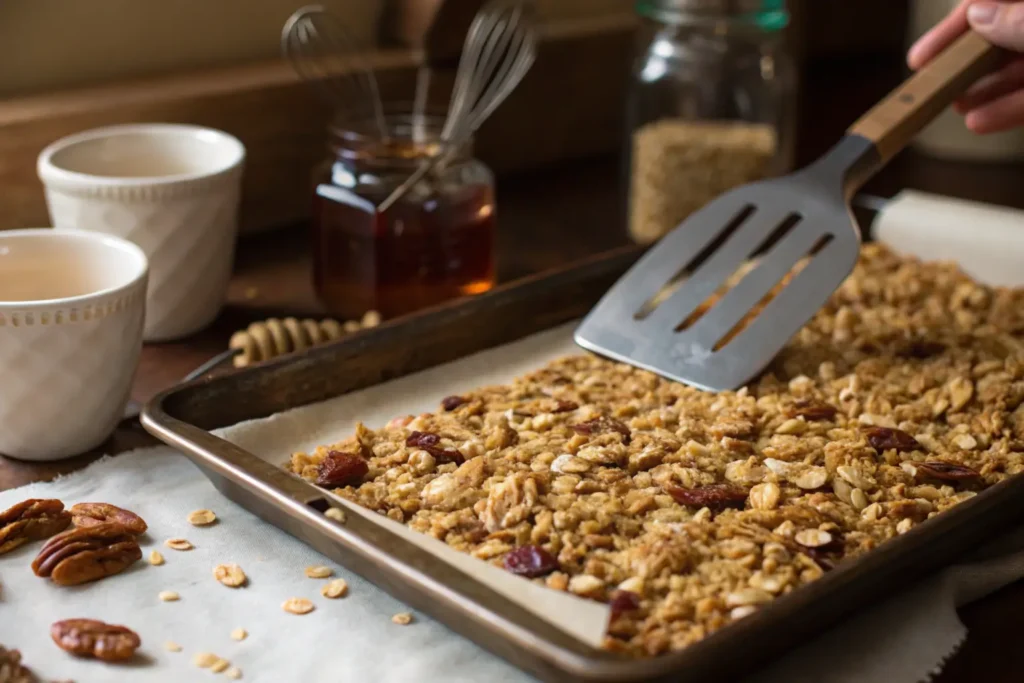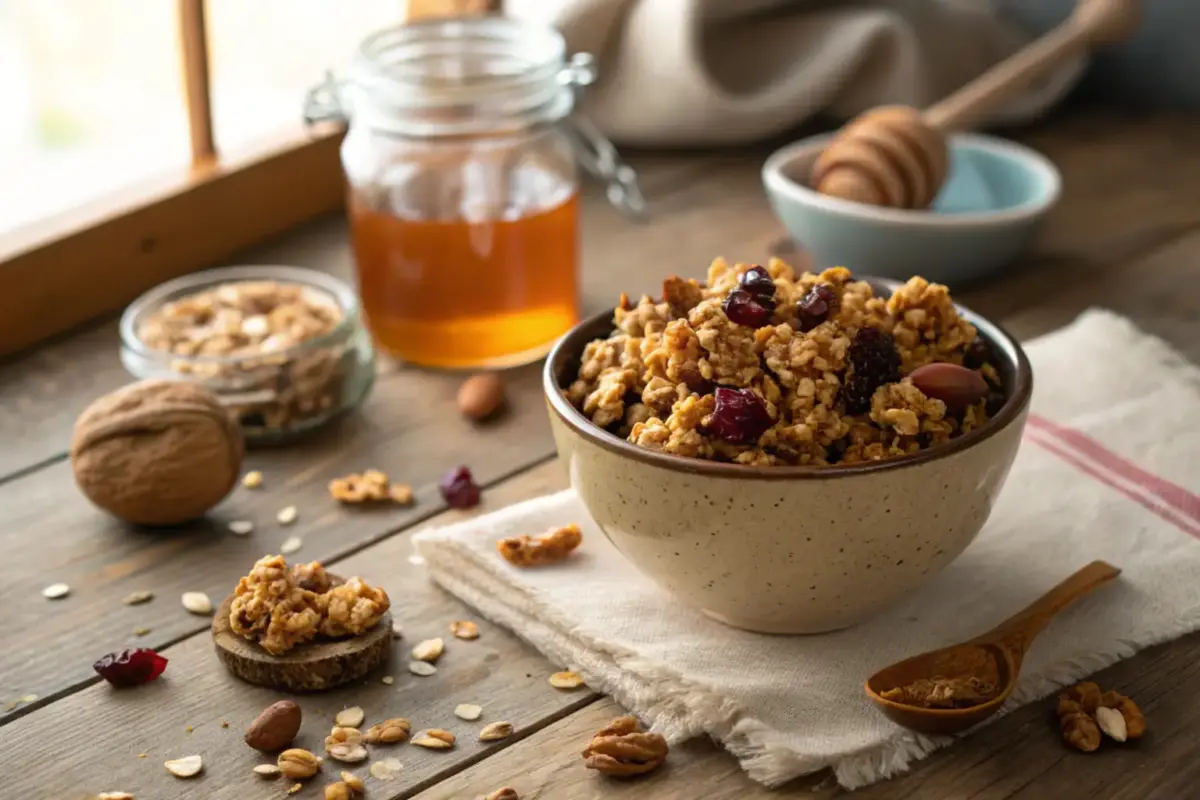Introduction
Let’s be real—there’s nothing quite like a bowl of homemade granola with those perfect crunchy clusters. But have you ever wondered what ingredient makes granola stick together? The secret lies in a mix of science, smart ingredient choices, and a few tried-and-true techniques. Every clump you love happens because of the right balance of moisture, binders, and baking techniques. Whether you’re new to granola-making or a seasoned pro looking to up your game, understanding what ingredient makes granola stick together can make all the difference. From the sweetness of honey to the smooth texture of nut butters, each ingredient has a role to play in creating those golden clusters. And, honestly, making it yourself is way more satisfying than buying it pre-made. So, grab your oats, line that baking sheet, and let’s dive into the secrets behind the ultimate homemade granola.
The Science Behind What Makes Granola Stick Together
Understanding Binding Agents in Granola
Granola’s texture relies on binders that hold oats, nuts, and seeds together. Ingredients like honey, maple syrup, and nut butters create the perfect clusters. To enhance your recipe, check out how brown sugar is used in recipes like brown sugar in cheesecake to understand its caramelization effects.
The Role of Moisture in Making Granola Stick Together
Here’s the deal: moisture plays a huge role in forming clusters. Too much liquid, and you might end up with soggy granola. Too little, and those oats won’t stick together. The trick is finding that sweet spot where the ingredients bind without over-saturating the mix. A touch of moisture helps the sugars caramelize and glue everything in place once baked.
Common Ingredients That Make Granola Stick Together
Honey: The Natural Sweetener That Binds Granola
Honey isn’t just delicious—it’s one of the most effective natural binders for granola. Its sticky texture and caramelization during baking give granola that satisfying crunch and chew. Plus, it’s a classic ingredient that adds a hint of sweetness without overpowering the flavor.
Maple Syrup: A Flavorful Ingredient That Helps Granola Stick
If you’re all about adding a subtle, rich flavor, maple syrup is your best friend. It works similarly to honey, providing stickiness while also lending a warm, earthy sweetness to the granola. And hey, it’s a great vegan-friendly option too.
Nut Butters: Creamy Binders That Help Granola Stick Together
Want an extra layer of creaminess and flavor? Nut butters like almond or peanut butter do the trick. They not only bind the ingredients but also add a hint of nuttiness to your mix. Pro tip: warm the nut butter slightly to make it easier to combine with the other ingredients.
Want a fun variation? Try pairing these ingredients with a flavorful twist, such as in this vanilla nut granola recipe.
Flour and Powder Alternatives
Almond Flour for Texture and Binding
Almond flour isn’t just a trendy ingredient for gluten-free baking—it’s also a great binding agent for granola. Its fine texture helps hold the mixture together while adding a subtle nutty flavor. If you’re looking to make your clusters a little more dense and flavorful, almond flour is worth a try.
The Use of Oat Flour in Granola Clusters
Oat flour is another solid choice for binding granola. Since it’s made from the same base ingredient as most granola recipes, it blends in seamlessly. A sprinkle of oat flour can soak up some of the liquid binders and help create those satisfying clusters we all crave.
Techniques to Enhance Granola Stickiness
Mixing Liquids and Dry Ingredients Properly
Here’s the thing—getting the perfect mix is crucial. Make sure every oat, nut, and seed is evenly coated with your liquid binder. This step ensures all the ingredients stick together during baking. Use your hands if needed to really work the mixture into a cohesive mass. It’s messy, but totally worth it.
Pressing the Mixture Before Baking

Pressing the granola mixture firmly onto your baking sheet is a total game changer. Use a spatula or your hands to pack it down tightly. This step encourages the clusters to form and makes breaking the granola into chunks much easier after it’s baked.
Baking at the Right Temperature
Temperature can make or break your granola—literally. Low and slow is the way to go. Baking at a moderate temperature, around 300°F, allows the binders to work their magic without burning the mix. Keep an eye on it and stir gently midway through for even cooking.
Exploring Unconventional Binding Ingredients
Gelatin and Agar: Protein-Based Options
For those looking to experiment, gelatin or agar can act as unique binding agents. These protein-based options help create an almost chewy texture, making your granola clusters stand out. Agar is especially great if you’re sticking to a vegan diet.
Pectin for a Vegan-Friendly Solution
Pectin, commonly used in jams and jellies, can also work wonders in granola. It’s a plant-based binder that adds a soft but sturdy structure to the clusters. Plus, it’s easy to find in most grocery stores.
Oils in Granola: Their Dual Role
Coconut Oil: Aroma and Adhesion
Coconut oil does double duty in granola-making. Not only does it add a subtle tropical aroma that pairs beautifully with sweet and nutty ingredients, but it also acts as a binding agent to help everything stick together. As the granola bakes, the oil melts and coats the mixture, creating just the right texture. And let’s be honest, that faint coconut scent wafting from your oven is a bonus all on its own.
Other Plant-Based Oils as Binding Agents
If coconut oil isn’t your thing, there are plenty of other plant-based oils to choose from. Olive oil, for instance, lends a richer, savory flavor that works well in less sweet granola recipes. Avocado oil is another excellent option, thanks to its neutral taste and smooth texture. Whichever oil you go with, make sure to mix it evenly with the dry ingredients, so every bite gets that perfect level of crispness and cohesion. In the end, the type of oil you use can really bring out the flavors you want while holding the mix together effortlessly.
Sweeteners’ Impact on Clustering
The Sticky Sweetness of Brown Sugar
Brown sugar is one of the most reliable answers to what ingredient makes granola stick together. Thanks to its molasses content, it creates a caramel-like glue during baking that helps bind oats, nuts, and seeds. If you want granola that clusters beautifully, adding brown sugar is a smart choice. It not only provides a deep sweetness but also enhances the overall texture of your mix. Use it alongside other binders like honey or maple syrup to maximize its effect. However, moderation is key—too much brown sugar can make your granola overly sticky or even burn in the oven. If you’re troubleshooting why your homemade granola doesn’t stick together, chances are you’re missing the right amount of brown sugar or another sticky binder. Whether you’re making a large batch or just enough for a week, brown sugar can make a noticeable difference in your granola’s stickiness and flavor.
Syrups: Corn Syrup and Alternatives
Syrups like corn syrup and rice syrup are also fantastic binding agents when you’re figuring out what makes granola stick together. They’re perfect for creating chewy clusters that hold their shape even after baking. Adding syrup to your mix ensures the granola doesn’t fall apart when you break it into pieces. If you’ve been wondering why your homemade granola isn’t sticking together, syrups might be the missing element. While corn syrup works well for more traditional recipes, you can experiment with alternatives like rice syrup or agave nectar for a unique twist. These syrups add stickiness without overpowering the flavor of your granola. To get the best results, pair syrups with other binders like coconut oil or nut butters. Whether you prefer a sweet, caramel-like texture or a more neutral taste, syrups offer flexibility and consistency that make them a must-have for creating perfect granola clusters.
Troubleshooting Common Issues
What to Do If Granola Doesn’t Stick Together
If you’re asking yourself what ingredient makes granola stick together, the problem might lie in your binder-to-dry-ingredient ratio. Often, homemade granola fails to clump because it doesn’t have enough liquid binders like honey, syrup, or nut butter. Another key factor is how well the mixture is pressed before baking. If your granola doesn’t hold its shape, try adding a bit more of your chosen binder, such as honey or coconut oil, and pack it down firmly on the baking sheet. Avoid overbaking, as this can dry out the mix and prevent clusters from forming. Baking at a lower temperature, like 300°F, helps the binders caramelize without burning. If your homemade granola still isn’t sticking together, look at your sweetener choices—brown sugar, syrup, and honey are some of the best options to get the perfect clusters you’re after.
Avoiding Over-Drying During Baking
Why does homemade granola sometimes not stick together? Over-drying during baking is a common culprit. When granola bakes too long or at too high a temperature, the binders lose their effectiveness, leaving you with loose, crumbly oats instead of the clusters you want. Stick to a moderate oven temperature and avoid baking for too long. Another tip for better clustering is to let the granola cool on the tray without stirring it right away. As it cools, the sugars and oils harden, helping to form those satisfying clumps. When figuring out what ingredient makes granola stick together, focus on how binders like honey, brown sugar, and syrup interact with the baking process. Proper moisture levels and careful monitoring in the oven can transform your granola from a loose mixture into the perfect snack-worthy clusters every time.
Customizing Granola Recipes for Desired Clumps
Adding More or Less Binder
It’s all about balance. If you want larger, chunkier clusters, add extra binder to the mix. For smaller, lighter clusters, use less binder and spread the mixture more loosely on the baking sheet. Don’t be afraid to tweak the recipe to match your preferences.
Choosing the Right Ratios of Ingredients
The ratio of wet to dry ingredients plays a huge role in cluster formation. A good starting point is three parts dry to one part wet. From there, you can adjust based on your preferred level of crunchiness and stickiness.
The Final Step: Storage and Longevity

Preserving Freshness and Texture
Store your granola in an airtight container to keep it fresh. Adding a silica packet or storing it in a cool, dry place can extend its shelf life. Fresh granola tastes best, but it can last for weeks when stored properly.
Keeping Clusters Intact
Want to keep those clusters intact? Handle your granola gently when transferring it to storage containers. If you press it together slightly while it’s cooling, the clusters will hold their shape better during storage.
FAQs
What can you use to bind granola?
Common binding agents for granola include honey, maple syrup, brown sugar, nut butters, and oils. These ingredients help glue the oats, nuts, and seeds together while adding flavor and texture.
How to get granola to clump together?
To encourage clumps, make sure the mixture is well-coated with a binder, press it firmly onto the baking sheet before baking, and avoid stirring too much while it’s in the oven.
What is a good binding agent for granola?
Honey and maple syrup are two of the best binding agents for granola. They provide stickiness while caramelizing during baking, which helps form those iconic clusters.
Why does my homemade granola not stick together?
Your granola might not be sticking together if there isn’t enough binder in the mix or if it’s over-dried during baking. Adjust the binder and keep an eye on the baking time to fix this issue.
Conclusion
Now that you’ve learned what ingredient makes granola stick together, you’re ready to create the perfect batch of homemade granola. From the sticky sweetness of honey to the rich caramelization of brown sugar, every binder plays an important role in forming those irresistible clusters. If your homemade granola isn’t sticking together, remember to check your binder-to-dry-ingredient ratio and avoid over-drying during baking. By using the right binders, like maple syrup or nut butters, and pressing the mixture firmly before baking, you can ensure every batch is full of crunchy, satisfying clumps. Making granola at home lets you experiment with flavors and techniques, so don’t be afraid to adjust until you find the combination that works for you. Whether it’s for breakfast or an on-the-go snack, knowing what makes granola stick together will elevate your recipe and take your granola game to the next level.


5 thoughts on “What Ingredient Makes Granola Stick Together? Secrets to Perfect Clusters”